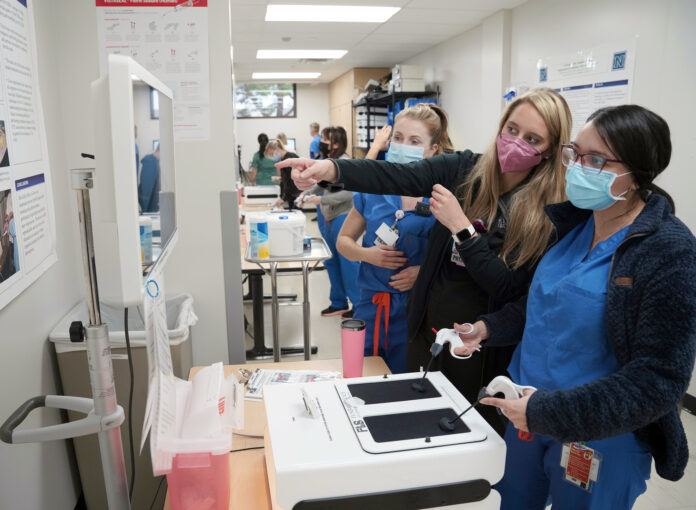Inside the Clinical Simulation Center of Las Vegas (CSCLV) medical and nursing students have an opportunity to practice real-life, high-fidelity situations in a no-stakes environment.
In a hospital room, a child “patient” lays in a hospital bed hooked to a telemetry display with the heart rate, oxygen saturation and blood pressure. The only clue in the room that it is not an actual hospital room is the large one-way mirror on the wall.
“So what’s gonna happen to me?” whined a simulation technician into a microphone to the student. Their voice resonates through the child mannequin on the bed across the glass divide. The patient-mannequins breathe, sweat, have palpable pulses, and dilate or constrict pupils with the click of a few buttons.
“The faculty, the concierge and the sim tech are working [together] and helping guide the learning here. It’s the faculty that is in charge,” said Rocky Rockstraw, the director of CSCLV. “When I am working with you as a teacher, I have to understand what level you are at.”
The first time Rocky worked directly alongside a physician was when he finished nursing school and entered the hospital as a new nurse. That was standard at the time but he felt that was an inherent flaw in his training.
Now, medical students and nursing students run codes together to simulate how each role contributes to the code and work together with the team leader to save the patient mannequin’s life or not.
Teaching interprofessional education is at the forefront of the simulation center’s mission. Shared communication is a core skill for healthcare workers when working as a team and is a skill that the center aims to develop. The center also focuses on teaching diagnostic skills, basic clinical skills, advanced clinical procedures and interpersonal skills such as family interactions.
Super Tory is another remarkable simulation, the latest and greatest technology, according to Rockstraw. When holding it, you need to support Super Tory’s neck like a real newborn. This 15-pound baby is a newborn simulation manikin that can have active muscle tone, appear jittery, grimace and cry like a real baby, grasp for air when in distress, turn blue to mimic cyanosis, and more.
Before health professionals enter clinical settings where real people’s lives are at stake, students have the opportunity to practice each of these skills and also how to integrate all of them at the same time.
“I have to tap into my inner pregnant woman to be the correct patient,” said Richard Dantes, simulation tech for ten years. “When we treat this like a real event, a real patient, everybody gets into it. It’s more realistic and it increases the fidelity of everybody’s experience.”
Whether or not the patient-mannequin survives or achieves the desired health outcome, the students and faculty have a chance to reflect together after the simulation in a learning-centered debriefing session. Together, faculty, students, and peers can reflect on what went right and what went wrong. Students can give peer feedback and learn from each other through in-depth, reflective learning.

